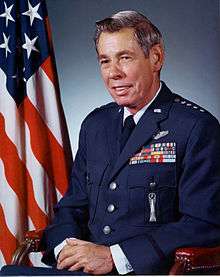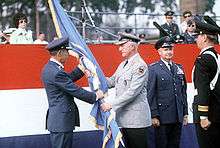Richard H. Ellis
| Richard H. Ellis | |
|---|---|
 Official portrait of General Richard H. Ellis, CINCSAC | |
| Born |
July 19, 1919 Laurel, Delaware, U.S. |
| Died |
February 28, 1989 (aged 69) Andrews AFB, Maryland, U.S.[1] |
| Buried at | Arlington National Cemetery, Virginia, U.S. |
| Allegiance |
|
| Service/branch |
|
| Years of service | 1941-1981 |
| Rank | General |
| Commands held |
Strategic Air Command Allied Air Forces Central Europe U.S. Air Forces in Europe 16th Air Force 9th Air Force |
| Battles/wars | World War II |
| Awards |
Distinguished Service Cross Air Force Distinguished Service Medal (4) Silver Star Legion of Merit (3) Distinguished Flying Cross Air Medal (5) Purple Heart |
Richard Hastings Ellis (July 19, 1919 – March 28, 1989) was a United States Air Force general who served as the commander in chief of the Strategic Air Command and director of the Joint Strategic Target Planning Staff with headquarters at Offutt Air Force Base, Nebraska. He was also director of the Joint Strategic Connectivity Staff.
Biography
Ellis was born in Laurel, Delaware, where he completed elementary and high school. He received his bachelor of arts degree in history from Dickinson College, Carlisle, Pennsylvania in 1941 and juris doctor degree from Dickinson School of Law in 1949. He was awarded an honorary doctor of science degree from Dickinson College in 1961; honorary doctor of laws degrees from Dickinson School of Law in 1974, from the University of Akron in 1979, and from the University of Nebraska, Omaha, in May 1981.
Ellis entered active military duty in September 1941 as an aviation cadet at Maxwell Field, Alabama. He received his commission and pilot wings at Turner Field, Georgia, in April 1942.
During World War II he served with the 3rd Bombardment Group in Australia, New Guinea and the Philippines, and flew more than 200 combat missions in the Western Pacific area. He served as a pilot, commander of the 90th Bombardment Squadron, group operations officer and, from September 1944, as group commander. In April 1945 General Ellis was assigned as deputy chief of staff, United States Far East Air Forces, in the Philippine Islands and Japan.
He requested release from active duty, became a member of the Air Force Reserve and entered Dickinson School of Law in 1946. He graduated in 1949 and, after admission to the Delaware Bar, practiced law in Wilmington, Delaware. He was recalled to active duty in October 1950 and assigned first to Headquarters Tactical Air Command, Langley Air Force Base, Virginia; then as deputy for operations, 49th Air Division, Sculthorpe, England; and later as chief, Air Plans and Operations Section, Supreme Headquarters Allied Powers Europe.
From January 1956 to May 1958, Ellis was deputy chief of staff, operations, Headquarters Nineteenth Air Force, Foster Air Force Base, Texas. He was then assigned to the Directorate of Plans, Headquarters U.S. Air Force, Washington, D.C., first as chief, Weapons Plans Branch, then as assistant director of plans for war plans, and later as assistant director of plans, joint matters.
In July 1961 Ellis become executive to the chief of staff, U.S. Air Force. From August 1963 to June 1965, he commanded the 315th Air Division, Tachikawa Air Base, Japan. He returned to Washington, D.C., and served as deputy director, J-5 (Plans and Policy), with the Joint Staff. In August 1967 he returned to the Air Staff, this time as director of plans. He assumed command of 9th Air Force with headquarters at Shaw Air Force Base, South Carolina, in September 1969.
He was appointed vice commander in chief of U.S. Air Forces in Europe in September 1970. General Ellis become commander, 6th Allied Tactical Air Force, with headquarters at Izmir, Turkey, in April 1971; and commander of Allied Air Forces, Southern Europe, with headquarters at Naples, Italy, in June 1972. He assumed additional duty as commander, Sixteenth Air Force, Torrejon Air Base, Spain, in May 1973.

He served as Vice Chief of Staff, U.S. Air Force, from November 1973 to August 1975. He was then appointed commander, Allied Air Forces Central Europe, and commander in chief, U.S. Air Forces in Europe. He assumed command of SAC in August 1977.
Ellis was a command pilot and earned the Master Missile and the Parachutist badges. He has been awarded the Distinguished Service Cross, Air Force Distinguished Service Medal with three oak leaf clusters, Silver Star, Legion of Merit with two oak leaf clusters, Distinguished Flying Cross, Air Medal with four oak leaf clusters, Purple Heart and Grand Officer of the Italian Republic. He was awarded the State of Delaware Distinguished Service Medal by Governor Walter W. Bacon in 1946. In September 1980 he was presented the Air Force Association's highest honor, the H.H. Arnold Award for significant contributions to national defense. As the recipient of this award he was also named as the association's National Aerospace Man of the Year. General Ellis received the Korean Order of National Security Merit, First Class (Tong Il Jang) on May 13, 1981, at the Korean Ministry of National Defense in Seoul. This award, the highest honor given by the Republic of Korea to a foreign military leader, was presented to the general for his important contributions to national defense of the Republic of Korea.
He was promoted to General on November 1, 1973, with date of rank September 30, 1973. He retired from the Air Force August 1, 1981.
General Ellis died March 28, 1989 at the age of 69.
References
- ↑ Michael Robert Patterson. "Richard Hastings Ellis, General, United States Air Force". Arlingtoncemetery.net. Retrieved 2011-12-21.
External links
| Wikimedia Commons has media related to Richard H. Ellis. |
| Military offices | ||
|---|---|---|
| Preceded by Russell E. Dougherty |
Commander, Strategic Air Command 1977—1981 |
Succeeded by Bennie L. Davis |
![]() This article incorporates public domain material from the United States Government document "".
This article incorporates public domain material from the United States Government document "".
